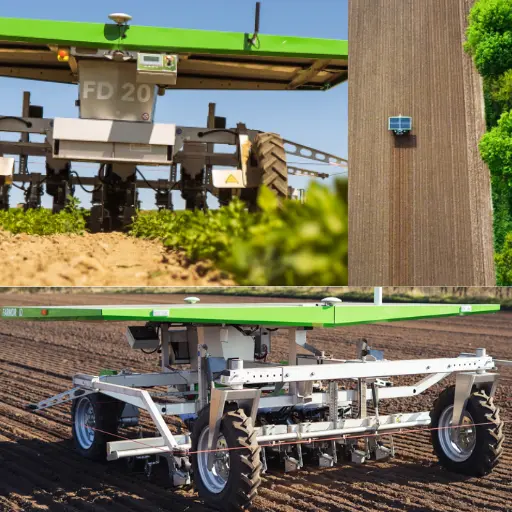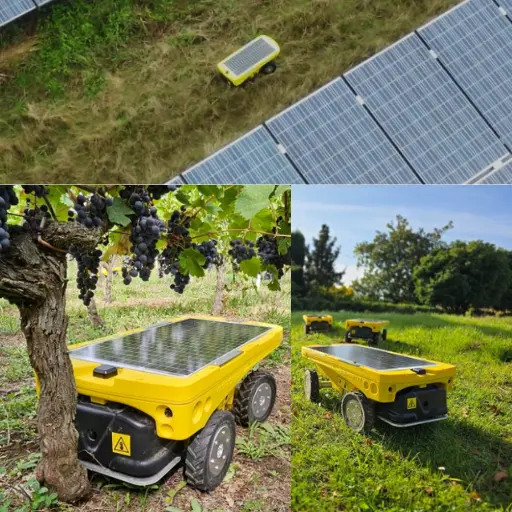This article is an update on our Emerging Ag-Tech series focused on solar energy technology. We include an agrovoltaic overview and new agrovoltaic installations and technology examples. We have also included a spotlight on new solar-powered farm vehicles.
Incorporating solar energy on farms is not a new idea. Increasingly, farmers are relying on solar power to offset rising energy costs and decrease their carbon emissions. Most farm supply or hardware stores stock a variety of portable solar panels, batteries and generators, and a quick search reveals many companies offering custom large panel installations specific to agriculture. Some farmers have been able to take advantage of government grants and subsidies to help offset the cost of installing as well (though recent changes to USDA climate programs have complicated funding paths in the US).
On-farm solar power is easily integrated into processes that require regular energy use like:
- Lighting and Ventilation: Solar panels can offset electricity costs for barns, greenhouses, and other structures by powering lights, fans, and ventilation systems.
- Solar Fencing: Livestock or deer fencing systems have more solar power options, which is especially useful in remote grazing locations or fields with high-value crops prone to deer foraging.
- Irrigation Systems: Solar-powered pumps can draw water from wells or reservoirs for irrigation, reducing reliance on grid electricity and potentially lowering operating costs.
- Machinery Charging: Some electric tractors, utility vehicles, and other farm equipment can be charged using solar power, decreasing fuel expenses and emissions.

What is Agrovoltaic?
First developed in the 1980s in the Netherlands, agrovoltaic is the practice of simultaneously using farm land for both solar energy generation and agricultural production. Solar panels are installed above or integrated into farmland, allowing crops to grow beneath them while generating electricity. It involves strategically designing and positioning solar panels to optimize both electricity production and crop growth.
Adolf Goetzberger, the originator of agrovoltaic, developed several criteria in order to classify on-farm solar panels as agrovoltaic.
- Neither energy capture nor farming activities can be compromised by the other
- Both energy generation and food production should be optimized and maximized
- The system needs to be able to support environmental goals and protection of the land, including efficient water use, soil regeneration and enhancing biodiversity
- The system creates a win-win situation, where both agriculture and solar energy production thrive, exceeding the results they would achieve individually.
Some crop types, varieties and climates are better suited for agrivoltaics. Some of the most common and studied crops paired with solar panels are:
- Leafy Greens and Herbs: These tolerate shade well and benefit from the diffused light conditions often found under solar panels.
- Berries: Certain berry varieties show tolerance to shade and can benefit from the cooler microclimate created by solar panels.
- Grapes: Depending on the grape variety and the climate, some can tolerate partial shade and may benefit from reduced heat stress under solar panels.
- Fallow / Feed Crops: Crops grown for fallow or pollinators can also benefit from solar panel shade protection. Additionally, some fallow agrovoltaic systems allow for animals to graze, eliminating the need to plan harvest processes under panels.

Advances in Agrivoltaic Technologies
Greenhouse agrovoltaic tech is taking off with the advent of translucent solar panels. Previously, solar panels have totally blocked light from passing through them, making them ill-suited for greenhouse agriculture relying on natural light for plant growth. A recent installation of Voltiris panels at a Tomato Master’s greenhouse is a game changer for integrating solar panels in more light-hungry crops, like tomatoes and peppers. These ceiling-installed panels let 96% of light pass through. This limited light diffusion does not inhibit plant growth and, in fact, can help with water retention and offsetting climate control costs.
Advances in solar panel tech recently have also enabled new orchard agrovoltaic installation options. German crop protection company Voen, in conjunction with Fraunhofer Institute for Solar Energy Systems ISE, recently published an announcement about a combination hail net and solar panel installation on a cherry orchard. The panels used in this installation are lightweight enough to be held up by hail net structures. This is great news for orchards that have already invested in hail netting, a substantial expense. Being able to leverage this expense to offset energy costs is a great opportunity for fruit growers.
Adjustable and custom greenhouse roof solar panel installations are becoming more popular in new greenhouse development as well. A recent 3.5-hectare kiwi greenhouse in France, built by Richel Group for Les Vergers de la Teyssonne, is an impressive example of this. According to Richel Group, “a specific support system was developed to enable the creation of a 'pergola' style growing structure, using the structure of the greenhouse itself, so the farmer did not have to invest in a separate support system.” As climate change advances and global temperatures rise, building greenhouses with shade while leveraging solar energy is a smart investment.
Solar Farm Vehicle Technologies
Among some farmers looking to offset their energy costs and reduce their environmental impact, solar-powered farm vehicles are gaining traction, offering both environmental and economic advantages. Farmers can significantly reduce fuel costs, freeing up capital for other investments. Additionally, electric motors generally require less maintenance than combustion engines due to fewer moving parts, minimizing downtime and repair expenses.
The adoption of solar-powered robots further enhances efficiency and precision in farming operations. Equipped with sensors and autonomous navigation capabilities, these robots can perform tasks like weeding with remarkable accuracy, minimizing crop damage and maximizing yields. Moreover, they can collect valuable data on soil conditions, crop health, and other parameters, enabling farmers to make informed decisions for optimized agricultural practices.
While initial costs may be higher compared to conventional equipment, the long-term benefits of solar-powered vehicles outweigh the investment. As technology continues to advance and costs decrease, we can expect these sun-powered workhorses to play an increasingly vital role in shaping a more sustainable and productive future for agriculture.
Below are a few examples of innovative on farm solar vehicles we have come across recently:
- FarmDroid FD20
- Use: Autonomous weeding robot for row crops like beets, carrots, and potatoes.
- Capacity: Weeds a surface area of approximately 1 hectare (2.5 acres) per day.
- Run Time: Can operate continuously for up to 20 hours on a single charge.
- Availability: Commercially available; pricing varies depending on region and configuration.

- Vitirover
- Use: Solar-powered robotic platform designed for vineyard maintenance tasks, including weed control, soil analysis, spraying treatments, and harvesting assistance.
- Capacity: Can travel up to 10 kilometers (6.2 miles) on a single charge. Specific payload capacity depends on the attached tool or module.
- Run Time: Up to 8 hours of operation per day.
- Availability: Commercially available; pricing is determined by the desired configuration and modules.

- Dutch E-Horse Tractor
- Use: Solar-powered electric tractor designed for small-scale farming and gardening tasks like plowing, cultivating, and hauling.
- Capacity: Towing capacity of approximately 1 ton (depending on terrain). Limited information available regarding acreage covered per charge.
- Run Time: Up to 8 hours on a single charge depending on load and usage.
- Availability: This is primarily a prototype or concept vehicle; commercial availability is unclear at this time.

As we've explored throughout this article, solar energy is transforming agriculture in exciting and innovative ways. From traditional on-farm solar installations powering barns and irrigation systems to cutting-edge agrovoltaic projects optimizing both food production and clean energy generation, the sun's potential is undeniable.
The emergence of solar-powered farm vehicles further underscores this shift towards sustainability. These electric workhorses not only reduce operational costs and dependence on fossil fuels but also demonstrate a commitment to minimizing environmental impact. With advancements in technology and design, we can expect even more efficient and versatile solar solutions tailored to the unique needs of modern farming.
Embracing solar power isn't just about adopting new technologies; it's about embracing a holistic vision for agriculture – one that prioritizes resource conservation, economic viability, and environmental stewardship. As farmers continue to innovate and explore the vast potential of solar energy, we can anticipate a future where agriculture thrives in harmony with nature, powered by the boundless energy of the sun.


